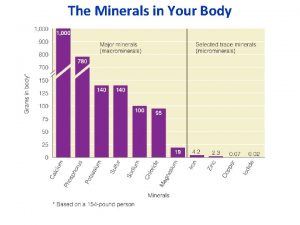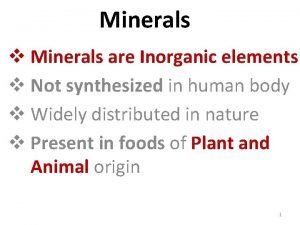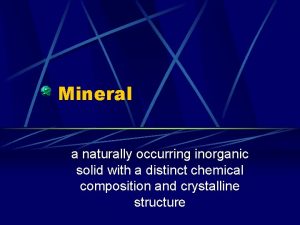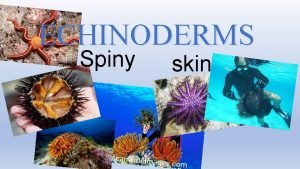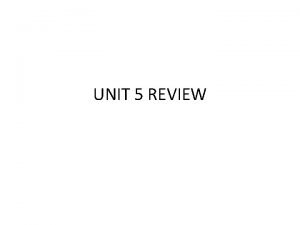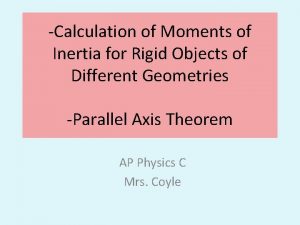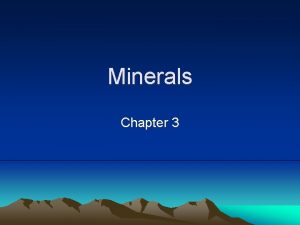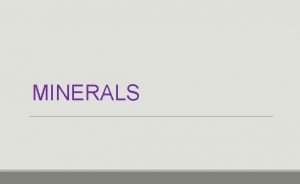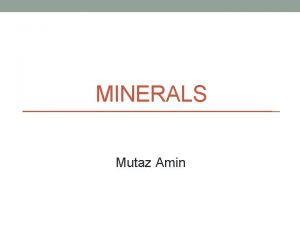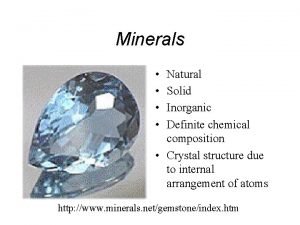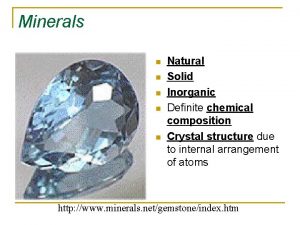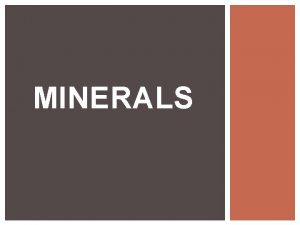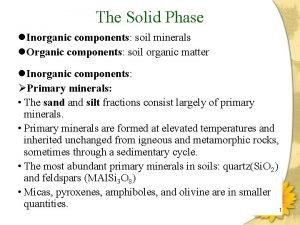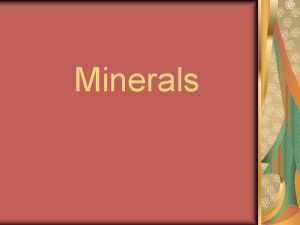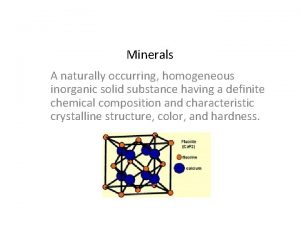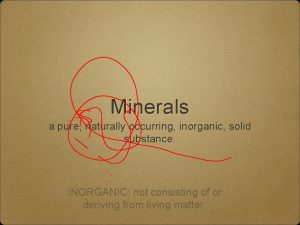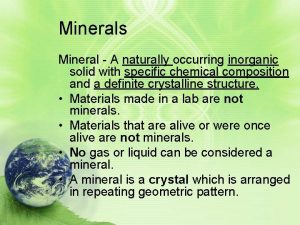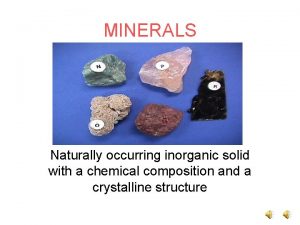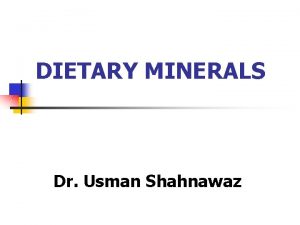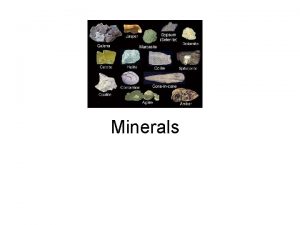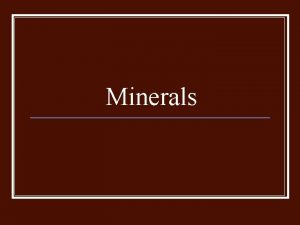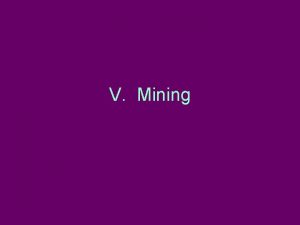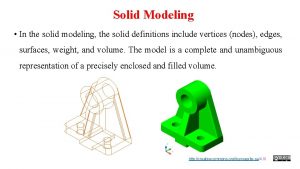Minerals Minerals Natural usually inorganic solid that has































- Slides: 31

Minerals

Minerals § Natural, usually inorganic solid that has a characteristic chemical composition, an orderly internal structure, and a characteristic set of physical properties.

Is it a Mineral? § § § Is it organic? Does it occur naturally? Is it a crystalline solid? Consistent chemical composition? Must answer yes to all 4 questions for it to be a mineral

10 Most common minerals § § § § Quartz Calcite Orthoclase Dolomite Plagioclase Halite Muscovite Gypsum Biotite Ferromagnesian Calcite Minerals These make up 90% of Earth’s mass

Mineral Groups § Silicates – 96% of Earth’s crust – Contains Si and O – Can have other elements also – Feldspar – Orthoclase if K, Plagioclase if Na or Ca – Ferromagnesian minerals – rich in Fe

Mineral Groups § Nonsilicate Minerals – Do not contain Si and O § Can contain one or the other, but not both – Six groups § Carbonates § Halides § Sulfates Native elements Oxides Sulfides

Crystalline Structure § Crystal – atoms, ions, or molecules are arranged in a regular, repeating pattern § Silicate crystal structure – Silicon – oxygen tetrahedron – 1 Si with 4 O’s around it – Basic building block of silicates – Can be connected 6 different ways

Crystalline Structure § Nonsilicate crystals – Diverse chemical composition leads to variety of crystal structures – Cubes, hexagonal prisms… – Crystal structure influences physical properties § Native elements are dense due to compact crystal structure

Silicate Tetrahedron

Physical Properties of Minerals § Mineralogist – Examine, analyze, and classify minerals § Result from chemical composition and crystal structure § Can be useful in identifying minerals

Physical Properties 1) Color 1. 2. 3. 4. Not reliable for ID purposes Small amount of impurities can affect color Weathered surfaces may hide color Only look at fresh surfaces

Color

Physical Properties 2) Streak 1. 2. 3. 4. 5. Color of mineral in powder form Streak plate – unglazed ceramic tile Streak color may differ from mineral color Metallic minerals – darker streak Nonmetallic minerals – lighter streak

Streak

Physical Properties 3) Luster 1. 2. 3. Light reflected from mineral’s surface Metallic luster – shiny surface Nonmetallic luster 1. 2. 3. 4. 5. Glassy Waxy Pearly Brilliant Dull / Earthy

Metallic Luster

Glassy Luster Quartz

Waxy Luster Variscite

Pearly Luster Talc

Brilliant Luster Diamond

Dull / Earthy Luster Psilomelane

Physical Properties 4) Cleavage / Fracture – Cleavage § splitting along specific lines of weakness § Forms smooth, flat surfaces – Fracture § Break unevenly into pieces § Forms curved, irregular surfaces § Conchoidal fractures – curved surface

Cleavage - Calcite

Fracture Conchoidal

Fracture Irregular

Physical Properties 5) Hardness 1. Ability to resist scratching 2. Mohs Hardness Scale 1. 2. 3. Scale of 1 to 10 1 = Talc 10 = Diamond Glass is about a 5

Mohs Hardness Scale

Physical Properties 6) Crystal Shape – 6 Basic shapes – Certain minerals always form crystals with the same shape 7) Density – Ratio of mass to volume – Can help identify minerals

Crystal Shapes

Physical Properties § § § Fluorescence and phosphorescence Chatoyancy and asterism Double refraction Magnetism Radioactivity

Double Refraction
 Minerals are inorganic elements that the body
Minerals are inorganic elements that the body Minerals are inorganic elements that the body
Minerals are inorganic elements that the body Naturally occurring inorganic solid material
Naturally occurring inorganic solid material Phân độ lown ngoại tâm thu
Phân độ lown ngoại tâm thu Block nhĩ thất độ 2 type 1
Block nhĩ thất độ 2 type 1 Thơ thất ngôn tứ tuyệt đường luật
Thơ thất ngôn tứ tuyệt đường luật Thơ thất ngôn tứ tuyệt đường luật
Thơ thất ngôn tứ tuyệt đường luật Walmart thất bại ở nhật
Walmart thất bại ở nhật Tìm vết của đường thẳng
Tìm vết của đường thẳng Hãy nói thật ít để làm được nhiều
Hãy nói thật ít để làm được nhiều Tôn thất thuyết là ai
Tôn thất thuyết là ai Gây tê cơ vuông thắt lưng
Gây tê cơ vuông thắt lưng Sau thất bại ở hồ điển triệt
Sau thất bại ở hồ điển triệt Crystalline vs amorphous
Crystalline vs amorphous Solid in solid solution
Solid in solid solution Covalent molecular and covalent network
Covalent molecular and covalent network Example of crystalline solid
Example of crystalline solid Crystalline solids
Crystalline solids Crystalline solid and amorphous solid
Crystalline solid and amorphous solid Crystalline solid and amorphous solid
Crystalline solid and amorphous solid When a solid completely penetrates another solid
When a solid completely penetrates another solid When a solid completely penetrates another solid
When a solid completely penetrates another solid Evaporation examples separation
Evaporation examples separation An uncontrolled railroad crossing usually has
An uncontrolled railroad crossing usually has An uncontrolled railroad crossing usually has a
An uncontrolled railroad crossing usually has a A small group usually has between three and twenty people.
A small group usually has between three and twenty people. Echinoderm means spiny skin
Echinoderm means spiny skin 6 faces
6 faces Volume of triangle
Volume of triangle Moment of inertia solid cylinder
Moment of inertia solid cylinder Natural hazards vs natural disasters
Natural hazards vs natural disasters Natural capital
Natural capital
